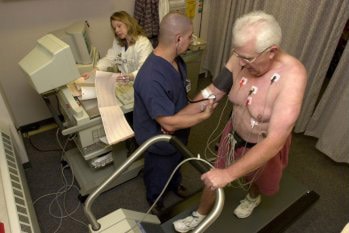 Exercise stress testing has been around for some time now. We use it for those low risk patients after exclusion of an AMI. We know the results aren’t great and that the pickup for single vessel disease is very low. In fact the overall sensitivity is about 68% and specificity of 77% (Lee NEJM 2001). These figure apply to the classic use of the stress test, i.e.., to predict the degree of coronary artery disease. In the Emergency Department, the stable coronary artery disease plaque, is of less interest to us as is the acute plaque, ie., the unstable plaque.
Exercise stress testing has been around for some time now. We use it for those low risk patients after exclusion of an AMI. We know the results aren’t great and that the pickup for single vessel disease is very low. In fact the overall sensitivity is about 68% and specificity of 77% (Lee NEJM 2001). These figure apply to the classic use of the stress test, i.e.., to predict the degree of coronary artery disease. In the Emergency Department, the stable coronary artery disease plaque, is of less interest to us as is the acute plaque, ie., the unstable plaque.
We need to think differently and use the stress test as a means of assessing those low risk patients who may have an unstable plaque, challenging them in the short term(not within 72 hours). Of course all precautions need to be taken and there is always the concern that patients stress tested may have an arrhythmia or arrest. This is really the purpose of the test in the emergency department, to identify those patients that have that unstable plaque. Those patients, that if you send home, may have a worst outcome.
J Amer Coll Cardiol 2002;40:251-256. In this study by Amsterdam et al, they exercise tested patients with low risk, on immediate presentation. Some had troponins taken, some had not. Those with a negative test were discharged. There were no complications from the stress testing and no death or AMI in a 6 month followup. 640 of 1000 patients had a negative test, 125 or 1000 had a positive test and 235 had a non-diagnostic test. This means that 765/1000 had either a positive or a negative test and could be sorted immediately.
Something to think about. The exercise test is not something to be done as an outpatient. It may, in fact be very useful to us in the ED.










